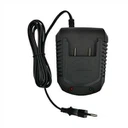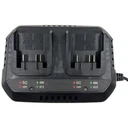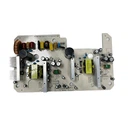Contact Us
- No.31 Xianghong Road, Xiang'an Distrcit, Xiamen City, Fujian Province, China
- echo-wang@eahunt.com
- +86-592-7616732

Power Adapters Manufacturers AC TO DC
An adapter is an interface converter, which can be a stand-alone hardware interface device that allows hardware or electronic interfaces to be connected to other hardware or electronic interfaces, or it can be an information interface. Examples include: power adapters, tripod base adapter...
Description
The power adapter, usually referred to as the DC regulated switching power adapter, is a rapidly developing electronic engineering discipline. As a result, the specific terms used to describe them are also still under development and have not yet been agreed upon and fully defined. The following list of terms, while not comprehensive, gives a general overview. In some cases, the common meaning of a term may differ from the special meaning in the application of a power adapter. In this case, the "ordinary meaning" is first given, and then the "special meaning" of the power adapter application is given.
1. Efficiency. The ratio of output power to input power expressed as a percentage. Note that because of the effect of the power factor limit, active power calculations must be used. Typically switching power adapters use a capacitive input filter with a power factor of about 0.63).
2. Thermal Protection. Special meaning: A method to prevent the failure of a switching power adapter in an overheated state. When the key components exceed the specified temperature, the power can be automatically turned off.
3. Overvoltage Protection Circuit (OVP). Special meaning: An independent circuit that prevents the output voltage from exceeding the specified maximum limit when the control circuit fails. This power supply protection circuit, when the output voltage is too high, the circuit can turn off the power supply or short-circuit the power output to the ground.
4. Power Regulation (Line Regulation). Special meaning: A power supply voltage change is usually expressed as the percentage of the output change caused over the entire range of input voltage changes.
5. Load Regulation. A change in the parameters of the controlled output due to a change in the defined load at the output under test. The percentage change in output resulting from a change in the defined load is usually given.
6. Mean Time Between Failure (MTBF). Is the average time between two failures, expressed in hours. Ideally, it is a statistical prediction of possible failures that can be measured against actual operational data. Predictions are more often based on statistical analysis of an accepted standard.
7. Common-Mode Ripple and Noise. The voltage or current component of ripple and noise that exists between an input or output line and a specified ground terminal.
8. Conducted electromagnetic interference (Constant-Current Limit). Part of the unwanted interference energy is conducted along the input or output of the switching power supply. Conducted EMI is regulated by national and international standards.
9. Constant-Current Limit. Special meaning: A method of overload protection, no matter how the load resistance in the overload protection range changes, the output current can remain rated.
10. Constant-Current Supply.
General meaning: Any kind of high internal resistance current source, its current is basically constant, and has nothing to do with the load device.
Special meaning: Describes a power supply whose main controlled parameter is output current. This power supply will keep the output current constant over the load resistance range, usually from 0V to a maximum range of a specified voltage.
11. Constant-Voltage Supply. A power supply whose main controlled parameter is the output voltage.
12. Converter. Special meaning: A term commonly used in switching power supplies that convert input DC voltage to output DC voltage and use transformer isolation.
13. Dynamic Load.
Common meaning: When the load can change, it is an active load. Special Meaning: An electronic load that can be changed rapidly to test the transient response of a switching power supply. It can also refer to an adjustable electronic load with a fixed current for testing.
14. Ambient Temperature. Common meaning: Ambient temperature in which the switching power adapter works
Special meaning: For convection cooling power supplies, it refers to the air temperature directly under the power supply in the position of free air flow. For fan cooling the power supply refers to the air temperature at the entrance of the fan. For conductive cooling components refers to the temperature of the heat exchanger surface.
15. Ground Loop. Special meaning: Usually in order to make the power supply at multiple common output terminals to ground the noise generated by the current loop. In switching power supplies, the grounding loop is often minimized by a common output ground at the output end of the power supply. If the system requires other ground terminals, a common-mode inductor can be connected at the output to minimize the loop current.
16. Holdup Time. Special meaning: is the time that the output voltage of the switching power supply remains within their specified range after the input AC power supply is removed.
17. Inrush Current. Special meaning: Peak input current value flowing into the power supply when the power transformer is first turned on.
18. Leakage Current. It is usually thought of as the current flowing between two parts that are isolated. In the switching power supply application of the medical IEC60601-1 standard, the leakage current of the ground circuit must be very low for safety. In this application, the current returned to the ground through any input filter is considered part of the leakage current.
19. Choke coil. An inductor specially designed to transmit a large DC current component. In order to prevent magnetic saturation, the choke usually has a core with an air gap or a special low permeability core.
20. Bleeder Resistor. Its main purpose is to provide load. For safety, it can be used as a capacitor discharge or load preset at the output end of the switching power supply to prevent the output voltage from rising too high after the external load is withdrawn. It is also called a false load resistor or a preset load resistor.
21. Short-Circuit Protection. Special meaning: A method of overload protection that prevents damage to the power supply in case of a short circuit at the output end of the power supply. In some flyback switching power supplies, they can withstand short circuits, but they cannot withstand long-term overload or short circuits.
22. Bandwidth.
Common meaning: It describes the frequency response of a system, usually referring to the frequency difference between a high frequency half-power point (down 3Db) and a lower frequency half-power point (down 3dB) or a frequency range of down 3dB.
Special meaning: When used in a switching power supply, it usually refers to a frequency segment over which the output ripple and noise components are specified or measured.
If you want to know more about switching power supply information, you can consult Xiamen Eahunt Electronics.
Whatsapp:+86 13860786068
Email: athene-cai@eahunt.com
Hot Tags: power adapters manufacturers ac to dc, China, suppliers, factory, customized, price, for sale
You Might Also Like












